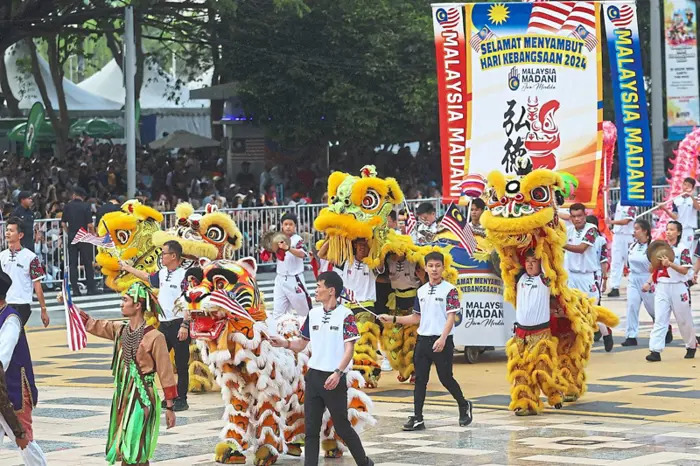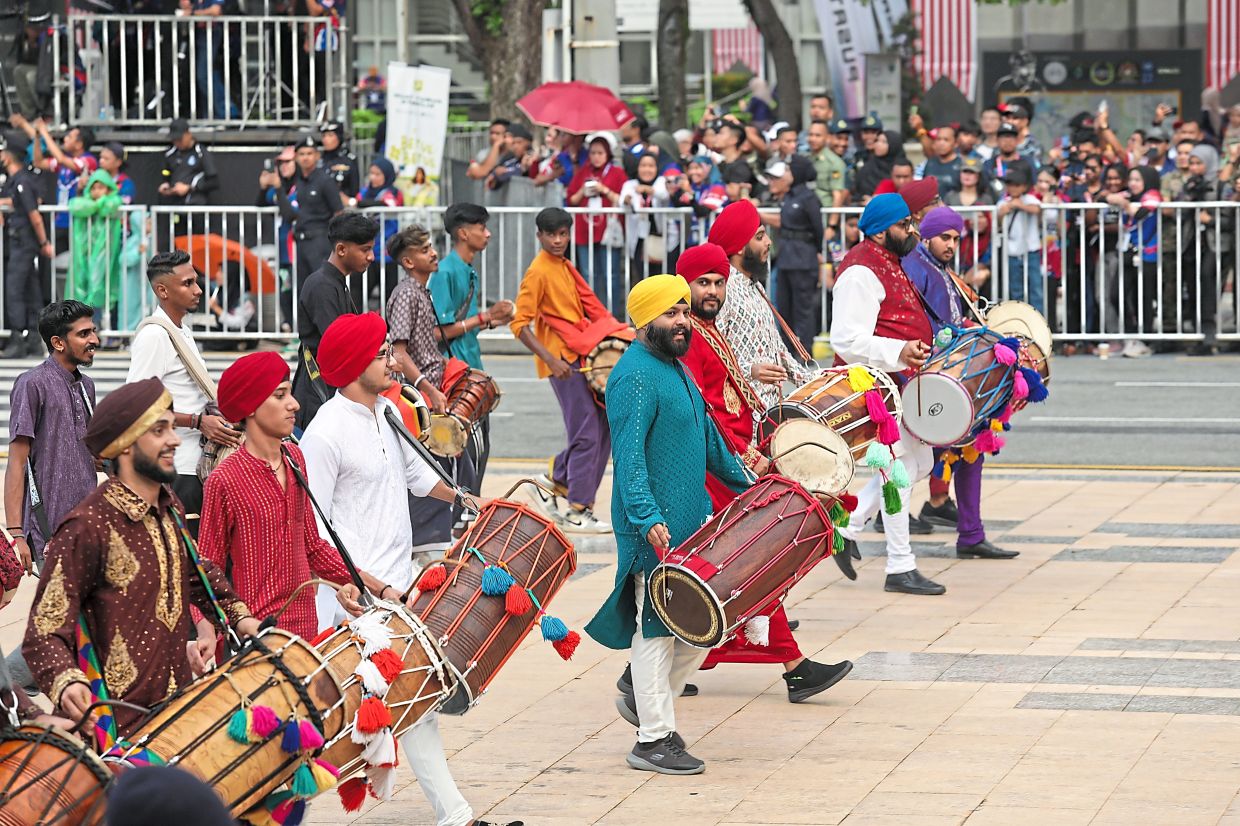
Diverse culture: The 67th National Day 2024 celebration at Dataran Putrajaya also included dragon and lion dances as well as urumi drumming and the bhangra dance (below), many of which making their national parade debut that day. — Photos: YAP CHEE HONG/The Star

THE National Day parade in Putrajaya on Aug 31 continues to be a popular conversation topic although it has been more than a week.
That’s simply because the nation continues to be divided by race and religious issues.
When the rare occasion takes place with diversity being openly displayed, there is a sense of acknowledgement of multiculturalism and multiracialism.
The Madani government, which has been facing criticism for being slow to institute reforms and fulfil electoral promises, deserves credit for putting on the best National Day parade ever.
Diverse traditional attire, culture and dances from various ethnic groups were showcased with over 800 participants dressed up in traditional costumes, complete with accessories.
The contingent included kompang performances, dragon and lion dances, a chingay parade, urumi drumming as well as bhangra and peacock dances, many of which making their national parade debut that day.
No ethnic group, including those from Sabah and Sarawak, was left out from the parade. There were even 10 warrior horses from the Bajau group from Sabah.
There was even a display of traditional costumes of the Orang Asli, the Siamese and the Peranakan communities, reflecting Malaysia’s diverse make-up.
The Malaysian Madani Community Contingent parade was led by the National Unity Ministry and certainly they stole the hearts of many Malaysians with its vibrance.
At the Bernama office, the home of the Malaysian National News Network, it was heartening to see National Day celebrated in a unique way.
Muslim women in tudung wore ethnic costumes from Sabah and Sarawak, Chinese women were in sarees and Malay men in Chinese clothes.
Malay staff also performed an improvised lion dance as their colleagues cheered.
At 63, I can safely say that I have watched many National Day celebrations, right from the time when the event was broadcast live over RTM in black and white.
Younger Malaysians may not realise but at one time in our nation’s history, there were politicians who openly frowned at lion dances being performed at public events.
I remember being involved in helping to organise the Mooncake Lantern Festival on campus in the 1980s and being “advised’’ by the university student affairs department not to have “too many lions” on stage.
How lion dances could be deemed as sensitive is incredulous but that was the toxicity then.
And now, Malaysia and China have signed an agreement to jointly nominate the lion dance to be listed for United Nations Educational, Scientific and Cultural Organisation (Unesco) cultural heritage, as well as Malaysia’s membership in the Alliance for Cultural Heritage in Asia.
Kudos must go to Communications Minister Fahmi Fadzil, who was tasked with organising the National Day parade, for taking this year’s parade to a higher level.
The expectations will certainly be higher next year and as expected, there will always be criticism as well.
The human graphic display on National Day displayed greetings in Malay, Chinese and Tamil – another first – but the fake information on social media which went viral was that only Chinese was used.
Then, there was a comment over a Malay news portal on Aug 31, titled “Jangan sampai budaya Melayu hilang di dunia’’ expressing concern that the Malay culture and use of Bahasa Melayu were eroding with less usage.
But in an ironic way, the PAS governments in Kelantan and Terengganu have been the ones who are responsible for killing off several Malay cultural activities.
Even the elegant baju kebaya is in danger of becoming extinct as PAS equates Arabisation with Islamisation at the expense of Malay identity.
The position of Islam and the special rights of Malays is clearly stated in the Federal Constitution and no one should question it.
The long and short of it is that it has not been easy for the Madani government as the main party of Pakatan Harapan is Parti Keadilan Rakyat, a multi-racial party.
For the first time in the country’s history, a multi-racial political party helms the government but the reality is also that the country’s demographic has changed dramatically since 1957 with 70% of the population being Malays and bumiputras.
The government must balance the demands and expectations of the country’s electorate in a delicate and sensible way. Managing race relations is never easy.
After over six decades of independence, Malaysia is at a crossroads, and while we rather stick to niceties at a time of celebration, many of us have also wondered where Malaysia is heading.
The country’s independence would not have been achieved without the efforts of the Malays, Chinese and Indians. Malaysia would not have formed without Sabah and Sarawak.
Let us reaffirm this in our textbooks, so that our young understand that Sabah and Sarawak did not join Malaysia but they helped form Malaysia as equal partners.
The country has progressed by leaps and bounds because Malaysians of all races and religions have toiled to build it.
The Malays in the police, army and civil service have kept the country safe, sound and stable, let us not forget.
By and large, Malaysians are peaceful, tolerant and moderate people, and for that, we must always be respectful of each other to keep Malaysia intact. There is no room for rabble rousers.
Politicians and religious preachers certainly should take the rap, but so could ordinary Malaysians.
Many have become brazen with racial and extreme religious views being amplified in recent years because of social media.
The government and police regularly warn of actions being taken against those who violate the 3R – race, religion and royalty – but the perception so far is that they have only acted against those who criticised the Rulers.
Former Prime Minister Tan Sri Muhyiddin Yassin is facing a sedition charge with the action coming swiftly following a royal rebuke.
But the nation still awaits action against religious preachers who have brazenly used religion to run down non-Muslims.
Despite numerous police reports being lodged and these recalcitrants being asked to give their statements to the police, we have not seen these cases being taken forward.
The days of politicians thumping at the rostrums, playing racial cards and displaying their political masculine postures and brandishing keris or swords, are over.
It doesn’t help and they won’t get the votes if they wish to re-invent themselves. Worse, they will lose the votes of non-Malays who will still prefer them if they remain moderates because the other political option is simply worse.
No federal government can also be formed without the support of Sabah and Sarawak, and that is a fact.
The display of diversity should not be featured only at National Day parades and tourism promotion dances. All of us should be made to feel we are Malaysian every day.
After 67 years of independence, there shouldn’t be any need to harp on race and religion, by right.
Diversity is an asset of Malaysia and it should be celebrated openly as in the National Day parade and not merely tolerated.











